tomiseksj
Moderator  Woodbridge, Virginia, USA
Woodbridge, Virginia, USA
Posts: 6,385  What I collect: Worldwide stamps/covers, Cinderellas, Ohio Prepaid Sales Tax Receipts, U.S. WWII Ration ephemera
What I collect: Worldwide stamps/covers, Cinderellas, Ohio Prepaid Sales Tax Receipts, U.S. WWII Ration ephemera
|
Post by tomiseksj on Sept 28, 2013 22:20:38 GMT
 After winning the above in The Stamp Forum’s inaugural donation auction, I sought reference material and the counsel of Mr. Ernesto Cuesta, a member of the APS expert committee for Cuban stamps since 1994 and host of the website FILACUBA which is dedicated to the study and promotion of Cuban Philately. Mr. Cuesta informed me that fractional usage was more prevalent from small towns where supplies of stamps were scarce or towards the end of the year when the more frequently used values of the currently circulating stamps were exhausted before being replaced by the next year's issue. He advised that diagonal halves or quarters on piece are very hard to authenticate and recommended that anyone who might be interested in collecting them should try to get them on full covers or folded letters where it can be verified whether the postal rate that they were paying explains the use of the bisect or quadrisect. |
|
tomiseksj
Moderator  Woodbridge, Virginia, USA
Woodbridge, Virginia, USA
Posts: 6,385  What I collect: Worldwide stamps/covers, Cinderellas, Ohio Prepaid Sales Tax Receipts, U.S. WWII Ration ephemera
What I collect: Worldwide stamps/covers, Cinderellas, Ohio Prepaid Sales Tax Receipts, U.S. WWII Ration ephemera
|
Post by tomiseksj on Sept 28, 2013 22:23:11 GMT
A search of Ernesto Cuesta’s bibliography of Cuban philatelic literature reveals about two dozen sources with mention of bisects. Three of the works cited refer to decrees issued in 1880, 1888, and 1891 which authorized the use of bisected 10c stamps in place of 5c stamps. Two of those decrees specifically mentioned the need to do so due to a shortage of 5c stamps. The 1891 decree, issued by the Postmaster General in Puerto Principe, authorized the use to pay the postage for interior mail, but specifically prohibited bisected stamps on foreign mail. One of the most promising references, described in the bibliography as an “Excellent account of Cuban bisects based on the author’s research and personal collection and those of two contemporaries, Samuel L. Israel and Joseph S. Steinmetz…” is an article by L. M. Rellim that was published in the December 19, 1931 issue of the Weekly Philatelic Gossip (Vol. XVI, No. 39). An internet search revealed that the Spellman Museum of Stamps & Postal History at Regis College (Weston, Massachusetts) had that publication in its holdings. Shortly after making an inquiry of the Spellman Resource Center & Library, a copy of the 6-page Rellim article arrived in the mail. 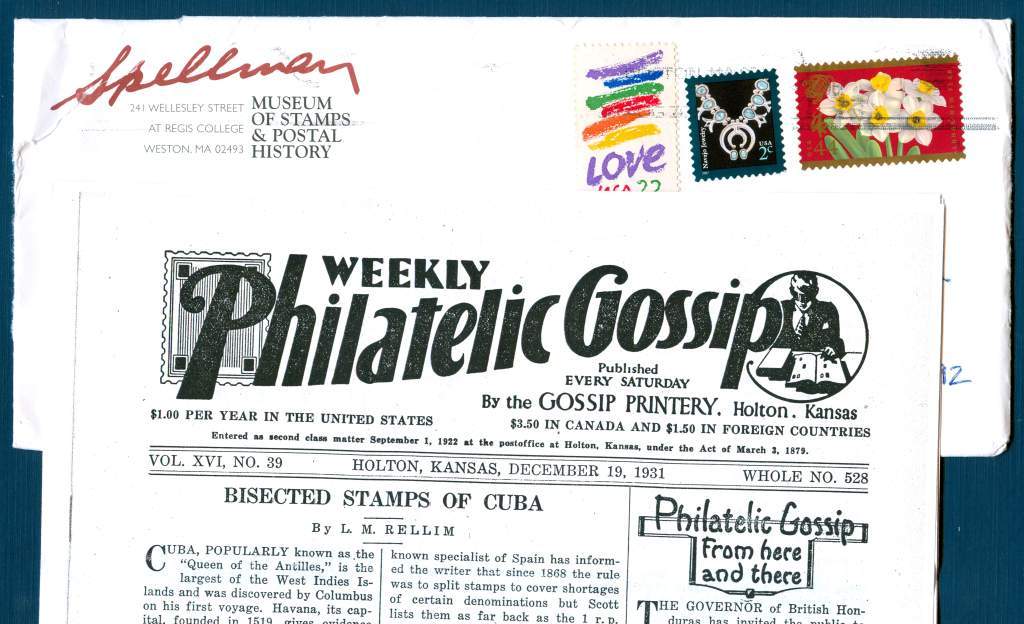 Rellim’s article not only provides an accounting of known bisects, it also documents the disparity in catalog listings between Scott and Michel existing at the time of publication. The author discusses bisects in three distinct groupings: Spanish West Indies (from 1862 to 1871 when stamps were issued for both Cuba and Porto Rico); Cuba 1873-1875; and, the Issues of Alfonso XII (1876-1889; “most of the bisected stamps of the island emanate from this period”). He also notes that, “All of the bisects as a rule are diagonally cut, either from upper left to lower right or from upper right to lower left, and used for half of their respective value.” An exception was the split of the 25c stamp of 1871, which was used for the franking value of only 12 (the subsequent rate of 12.5c didn’t come into effect until 1873 when the 12.5c dark green stamp bearing the portrait of King Amadeo was issued. |
|
tomiseksj
Moderator  Woodbridge, Virginia, USA
Woodbridge, Virginia, USA
Posts: 6,385  What I collect: Worldwide stamps/covers, Cinderellas, Ohio Prepaid Sales Tax Receipts, U.S. WWII Ration ephemera
What I collect: Worldwide stamps/covers, Cinderellas, Ohio Prepaid Sales Tax Receipts, U.S. WWII Ration ephemera
|
Post by tomiseksj on Sept 28, 2013 22:27:56 GMT
Four different currencies were in play in Cuba during the periods covered by Rellim’s three groupings. The following information, extracted from the Pichs collection, addresses some key dates in Cuba’s early postal history: - Spain issued its first postage stamps on January 1, 1850.
- In Cuba, the first postage stamps were placed on sale on April 24, 1855.
- Stamps in a new decimal currency were introduced on January 1, 1866. Monetary units changed from reales plata fuerte to céntimos de escudo. One hundred céntimos equaled one escudo. One half real plata fuerte equaled 10 céntimos, the single letter rate within the island of Cuba; one real plata fuerte equaled 20 céntimos, the letter rate to Spain.
- The 10 centimos de escudo stamp issued on January 1, 1867 is the first Cuban issue appearing with perforations.
- Another currency change took place as of February 1, 1871. This time the currency had changed to 100 céntimos equaled one peseta. Valuations were now one half real plata fuerte, equaled 10 céntimos de escudo, equaled 25 céntimos de peseta.
- On January 1, 1877, the first issue depicting King Alfonso XII with the name of the colony appeared, in this case, "Cuba". Postage stamps issued previously had not indicated the name of the Spanish colony where they were to be used.
- Another currency change took place in January, 1881. The exchange rate now was one half real plata fuerte equaled 10 céntimos de escudo, equaled 25 céntimos de peseta, equaled 5 centavos de peso. Or, in other words, 5 céntimos de peseta equaled 1 centavo de peso. Thus, the postage rate to Spain for a single weight letter, which was formerly 50 céntimos de peseta, was now 10 centavos de peso.
|
|
tomiseksj
Moderator  Woodbridge, Virginia, USA
Woodbridge, Virginia, USA
Posts: 6,385  What I collect: Worldwide stamps/covers, Cinderellas, Ohio Prepaid Sales Tax Receipts, U.S. WWII Ration ephemera
What I collect: Worldwide stamps/covers, Cinderellas, Ohio Prepaid Sales Tax Receipts, U.S. WWII Ration ephemera
|
Post by tomiseksj on Sept 28, 2013 22:29:22 GMT
1873Quadrisect (right quartile) of the 50c brown, perf. 14, King Amadeo issue (Scott 56), presumably used as a 12.5c to pay the domestic single letter rate – a quadrisect of the 50c brown is not listed in the 2009 Scott catalog. 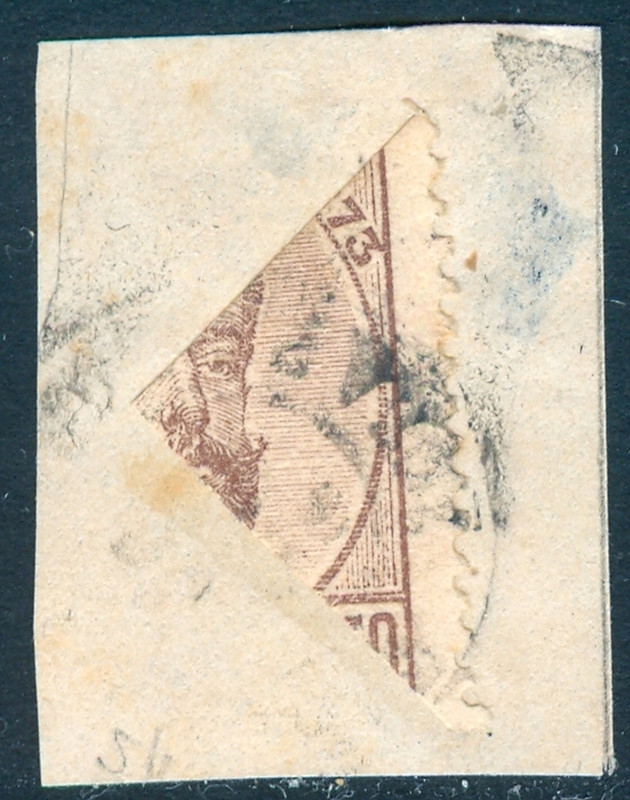
|
|
tomiseksj
Moderator  Woodbridge, Virginia, USA
Woodbridge, Virginia, USA
Posts: 6,385  What I collect: Worldwide stamps/covers, Cinderellas, Ohio Prepaid Sales Tax Receipts, U.S. WWII Ration ephemera
What I collect: Worldwide stamps/covers, Cinderellas, Ohio Prepaid Sales Tax Receipts, U.S. WWII Ration ephemera
|
Post by tomiseksj on Sept 28, 2013 22:30:28 GMT
1875Bisect (lower right half) of the 25c ultra Coat of Arms issue (Scott 64b), presumably used as a 12.5 c.  Bisect (lower left half) of the 50c blue green Coat of Arms issue (Scott 65b), presumably used as a 25c. 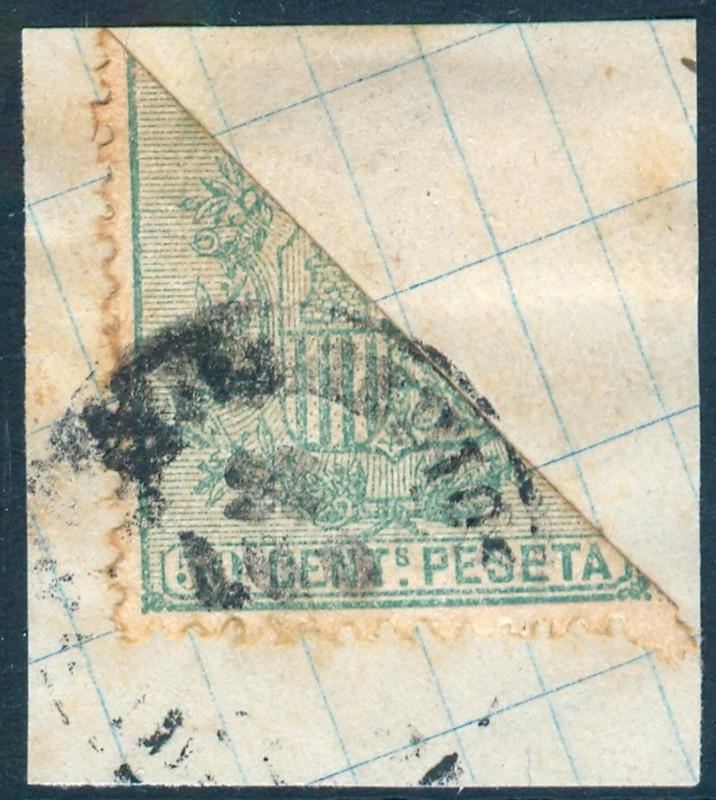
|
|
tomiseksj
Moderator  Woodbridge, Virginia, USA
Woodbridge, Virginia, USA
Posts: 6,385  What I collect: Worldwide stamps/covers, Cinderellas, Ohio Prepaid Sales Tax Receipts, U.S. WWII Ration ephemera
What I collect: Worldwide stamps/covers, Cinderellas, Ohio Prepaid Sales Tax Receipts, U.S. WWII Ration ephemera
|
Post by tomiseksj on Sept 28, 2013 22:31:04 GMT
|
|
tomiseksj
Moderator  Woodbridge, Virginia, USA
Woodbridge, Virginia, USA
Posts: 6,385  What I collect: Worldwide stamps/covers, Cinderellas, Ohio Prepaid Sales Tax Receipts, U.S. WWII Ration ephemera
What I collect: Worldwide stamps/covers, Cinderellas, Ohio Prepaid Sales Tax Receipts, U.S. WWII Ration ephemera
|
Post by tomiseksj on Sept 28, 2013 22:31:40 GMT
1880 Bisect (upper right) of the 25c gray blue King Alfonso XII issue (Scott 91a), presumably used as a 12.5c and postmarked Trinidad, Cuba on March 14, 1890. 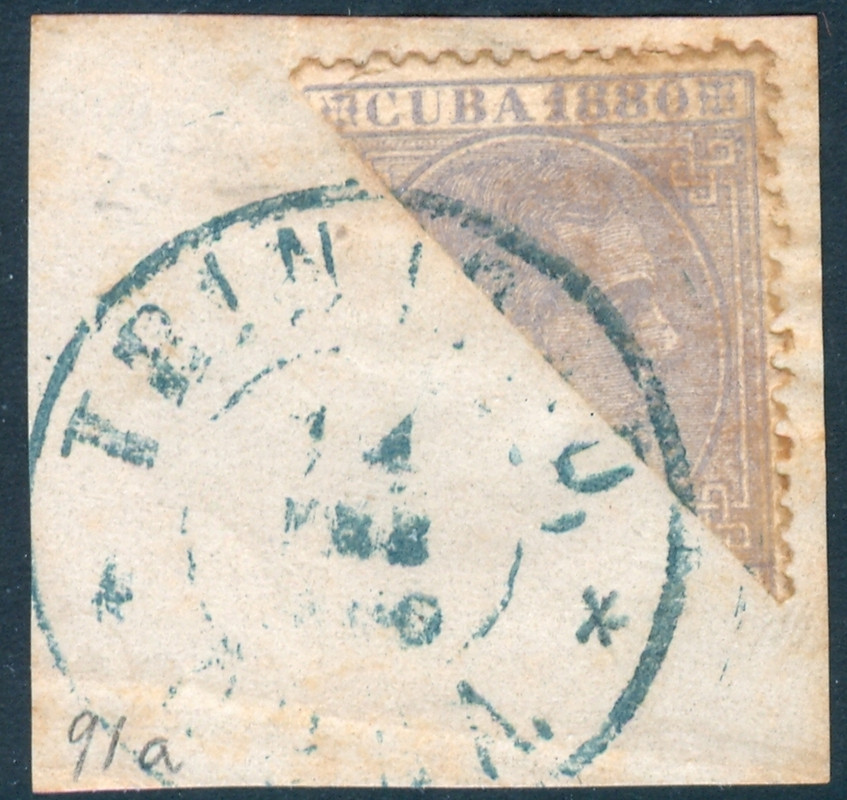 Bisect (upper left) of the 50c brown King Alfonso XII issue (Scott 92a), presumably used as a 25c 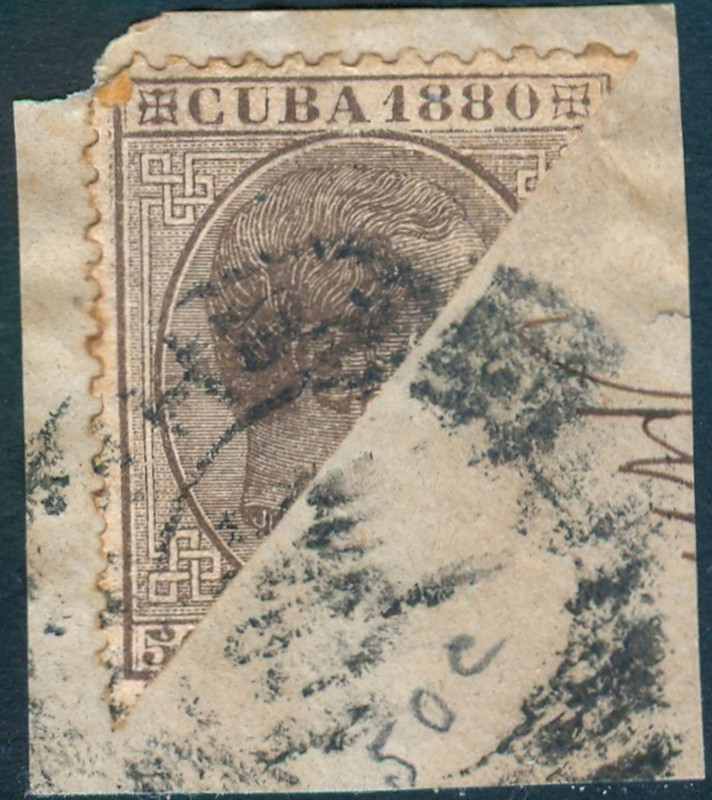
|
|
Admin
Administrator 
Posts: 2,676
|
Post by Admin on Sept 28, 2013 22:41:34 GMT
Glad to see you are having fun with them  |
|
tomiseksj
Moderator  Woodbridge, Virginia, USA
Woodbridge, Virginia, USA
Posts: 6,385  What I collect: Worldwide stamps/covers, Cinderellas, Ohio Prepaid Sales Tax Receipts, U.S. WWII Ration ephemera
What I collect: Worldwide stamps/covers, Cinderellas, Ohio Prepaid Sales Tax Receipts, U.S. WWII Ration ephemera
|
Post by tomiseksj on Sept 28, 2013 22:52:41 GMT
I couldn't have done it without you!!!
|
|
rod222
Member 
Posts: 11,043  What I collect: Worldwide Stamps, Ephemera and Catalogues
What I collect: Worldwide Stamps, Ephemera and Catalogues
|
Post by rod222 on Sept 28, 2013 23:46:15 GMT
Great Post Steve! I have to admit, was sore I missed out on those, they were a lovely lot. You have done them a great service with your study, and I enjoyed that immensely, Now I don't feel so bad  Well done you. |
|
tomiseksj
Moderator  Woodbridge, Virginia, USA
Woodbridge, Virginia, USA
Posts: 6,385  What I collect: Worldwide stamps/covers, Cinderellas, Ohio Prepaid Sales Tax Receipts, U.S. WWII Ration ephemera
What I collect: Worldwide stamps/covers, Cinderellas, Ohio Prepaid Sales Tax Receipts, U.S. WWII Ration ephemera
|
Post by tomiseksj on Sept 29, 2013 0:23:54 GMT
Thanks, Rod.
Your "shout" following the auction to the effect that you looked forward to hearing what I learned about them helped drive my effort.
And I can't say enough about the responsiveness of both Ernesto Cuesta and the Spellman Museum -- without the information that they provided, there would have been no such thread.
|
|